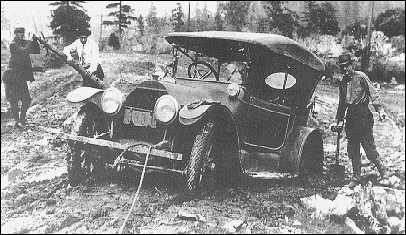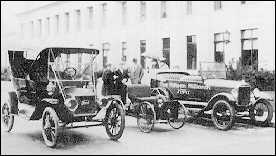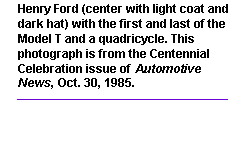
"The remedy must be as radical as the disease is deep-seated."
- Gen. Roy Stone, Oct. 20, 1892
As suggested by Gen. Stone a year before he became the federal government�s first special agent and engineer for road inquiry, the "disease" was bad roads. Well into the 20th century, calling them "roads" gives them more credit than they deserve. They were often little more than trails that were muddy in the rain and dusty the rest of the time. Any long trip by automobile required not only time, patience, and ingenuity, but tire-patching equipment, tools, spare parts, and emergency food and fuel.
Since the mid-19th century, roads had been universally recognized as a state and local responsibility. And if state and local officials let the roads deteriorate, so be it. That was their decision, and in an era when privately owned railroads dominated interstate travel and commerce, it was not a national concern.
This attitude began to change in the 1890s, when the bicycle revived interest in roads. New Jersey, in 1891, became the first state to adopt a "state-aid" plan, under which a state appropriates funds to be made available to its counties for road improvements. The federal government created the Office of Road Inquiry in 1893, under Stone, to advise state and local officials on the best methods of improving their roads.
Early in the 20th century, Stone�s successor, Martin Dodge, began advocating a similar concept of "federal aid" to the states. Dodge's assistant, M.O. Eldridge, drafted a federal-aid bill, which was introduced to Congress in December 1902 by Rep. Walter P. Brownlow of Tennessee. The bill would create a Bureau of Public Roads to administer $20 million a year in federal aid. Grants would be made to any state or county that agreed to pay 50 percent of the road construction cost. The federal government would prepare the plans and specifications for the roads, but the state or county would administer and supervise the contracts.
The Brownlow bill was not actively considered by Congress. Many members of Congress were not convinced the federal government had the constitutional authority to enact such a program. Others questioned the wisdom of embarking on a program that would be a constant drain on the treasury. Over the next decade, many other good-roads bills were introduced, but like the Brownlow bill, they were routinely assigned to committee and promptly forgotten.
Several factors gradually altered the reluctance to consider the federal-aid concept. First, the growing involvement of farmers in the good-roads movement reinforced the importance of roads in everyday life. Farmers who initially resisted being taxed to pay for good roads so wealthy city "peacocks" could ride their bicycles became enthusiastic advocates of good roads with the introduction of Rural Free Delivery (RFD), which depended on the existence of passable roads for home delivery of mail.
Second, the rise of the automobile in the early 20th century altered the picture, particularly after 1908, when Henry Ford introduced the low-priced Model T that the average person - not just the wealthy - could afford. The growing power of motorists was reflected in the American Automobile Association (AAA), which became one of the strongest backers of federal action on roads.
Third, the Supreme Court settled the constitutional question. In a 1907 case, Wilson v. Shaw, Justice David Brewer wrote that Congress had the power "to construct interstate highways" under the constitutional right to regulate interstate commerce.
Fourth, the founding of the American Association of State Highway Officials (AASHO) in December 1914 gave the states an effective voice for advocating a national road improvement program.
And finally, the right man appeared on the scene. He was Logan Waller Page, who, in 1905, became director of the Office of Public Roads (OPR). Page was a scientist who embodied the growing Progressive Era (1900-1920) spirit of his times. He believed that scientific experts could best address the nation�s road problems by applying apolitical judgment, based on irrefutable data, free of political taint and corrupt influence.
Page was a bitter foe of what he described in 1911 as "the cheap charlatanism of the professional promoter and the bungling efforts of the well-meaning but uninformed citizen." Throughout his tenure, while building the OPR into the national leader in the science of road building, Page exhibited prickly impatience with those who failed to live up to his standards.
In 1912, the growing need for an increased federal role was reflected in passage by the House of Representatives of a good-roads bill by a vote of 240 to 86. Introduced by Rep. Dorsey W. Shackleford of Missouri, the bill proposed a $25 million rental plan whereby the federal government would make a "rental" payment to the counties for the use of roads for mail delivery. The payments would then be used for road improvements that would help get farmers out of the mud.
The Senate failed to adopt the rental plan, in part because of the opposition of AAA and other motorist groups. As AAA saw it, a national road program should proceed, as railroad development had, by first building the most important lines, the long-distance arteries of commerce.


Here was the basic split that would have to be resolved before federal aid could become a reality. Farmers wanted all-weather, farm-to-market roads. Motorist groups and the automobile industry wanted hard-surfaced, interstate roads. Faced with these conflicting viewpoints,
Congress decided to study the issue in two ways. First, the Post Office Department Appropriations Bill for 1913 (enacted Aug. 24, 1912) appropriated $500,000 for an experimental program to improve post roads. The funds would be made available to state or local governments that agreed to pay two-thirds of the cost of the projects. Second, the act authorized a joint congressional committee to prepare a report on the issues involved in providing federal aid for highways.
The post road program was plagued with problems. Many state and local officials resented OPR�s oversight of their projects. According to a report to Congress on the program, local officials showed "a disposition frequently to avoid the obvious requirements of the present act." State and local officials also objected to certain federal requirements, such as a federal statute requiring an eight-hour day for workers and a 1915 executive order barring convict labor on government work. The U.S. attorney general eventually concluded that, because the projects were not the public work of the United States, these restrictions did not apply.
Ultimately, post road projects covered 735 kilometers of road in 28 counties in 17 states. Although these figures were disappointing, the program provided valuable experience that was reflected in later decisions on federal aid. The most important result was the realization that federal aid should go only to the states, not to the counties. OPR was too small to work with 3,000 counties, each with its own public works mechanism.
The joint committee, headed by Sen. Jonathan Bourne Jr. of Oregon, reported to Congress in January 1915. The committee dismissed the constitutional question and endorsed federal aid but was unable to resolve differences on the details.
Serious consideration of a federal road program began early in 1916 when the House of Representatives acted on Shackleford�s latest federal-aid plan. It authorized $25 million to improve "rural post roads," with the federal share being not less than 30 percent nor more than 50 percent. The funds would be apportioned to the states - half on the basis of population and half based on mileage of RFD and star mail delivery routes. (A "star route" was a delivery route awarded by contract to a private carrier.) The states would select projects, subject to federal review of surveys, plans, and estimates. All work would be under the supervision and control of the states. Beginning in 1920, any state receiving aid must have a state highway agency. The House approved the plan, 281 to 81, on Jan. 25, 1916.
Reaction was mixed. Southern Good Roads magazine summed up support for the bill: "... the Act is horse-high, bull-strong and pig-tight. It is pure business and without the least touch of sentiment."
By contrast, opponents thought the apportionment formula gave too little aid to the states that needed it the most. Others questioned spending so much for roads given the need for national defense funding since war had begun in Europe. Still others feared state and local officials would use federal aid for "pork" projects to reward political supporters; direct federal construction of a highway network was the solution to the "pork" problem.
The Shackleford bill was referred to the Senate Committee on Post Offices and Post Roads, headed by Sen. John H. Bankhead of Alabama. Bankhead, a long-time advocate of federal aid for roads, was also a close associate of Page. In considering federal aid in 1916, Bankhead would be guided by Page and, through him, by AASHO.
When AASHO was founded, the first order of business was the drafting of a federal-aid bill to be submitted to Congress. Initial efforts by AASHO were stalled because of conflicting interests among the heavily populated states that had already developed highway networks and the less-populated states that had not yet done so. In September 1915, during the Pan-American Road Congress in Oakland, Calif., a small group of AASHO members met to draft a federal-aid bill that struck a balance among the interests. Thomas H. MacDonald, chief engineer of the Iowa State Highway Commission and an associate of Page, headed the small group.
The AASHO bill proposed to appropriate $75 million over five years to be apportioned to the states by formula: one-third based on total area, one-third by population, and one-third by mileage of rural delivery and star routes. The federal share would be 50 percent, but payments could not exceed $10,000 per mile. Each state was required to have a state highway agency that would select the "rural post road" projects, but they would have to submit their programs of projects - as well as the surveys, plans, specifications, and estimates - to the Secretary of Agriculture for approval.
All improved roads must be free from tolls and must be maintained by the state. No money could be expended in any state until its legislature had agreed to the provisions of the act. The governor�s assent would be satisfactory until the legislature acted.
Bankhead amended the Shackleford bill by deleting everything after the enacting clause ("Be it enacted ...�) and substituting the AASHO bill. With Page providing factual, analytical, and other support, Bankhead took the bill to the Senate floor for debate. On May 8, 1916, the Senate approved the Bankhead bill with some amendments. In addition to the $75 million the bill authorized for federal-aid improvements, the Senate approved $10 million ($1 million per year for 10 years) for roads and trails within or only partly within the national forests.
Debate in the House and Senate had been extensive. Constitutional and states� rights issues were debated, as was the concern that the bill was establishing a "pork barrel." However, by far, the majority of the debate related to the formula for apportioning funds among the states and the exclusion of cities from the benefits of the act.
The House-Senate conference committee completed work on June 27 after making some changes in the Bankhead bill but leaving it largely in tact. Both houses approved the bill the same day.
The Federal Aid Road Act of 1916 was, in many ways, the embodiment of Page's ideals. Each state would have a highway agency with engineering professionals to carry out the federal-aid projects. Page and his engineers had approval authority so they could ensure the projects were designed and constructed properly. The 1916 Act also served the social function of enhancing life in rural America by focusing on rural post roads rather than the long-distance roads advocated by AAA and many others. As historian Bruce Seely said, "By incorporating this vision, the nation's first highway policy combined the Progressive goals of economic efficiency and social betterment."
On July 11, 1916, President Wilson signed the bill in a White House ceremony that was attended by members of Congress and representatives of AAA, AASHO, and farm organizations. The federal-aid highway program of federal-state cooperation was ready to go.
References
1. America�s Highways 1776-1976, Federal Highway Administration, Washington, D.C., 1976.
2. Bruce E. Seely. Building the American Highway System: Engineers as Policy Makers, Temple University Press, Philadelphia, Pa., 1987.

Richard F. Weingroff is an information liaison specialist in the Federal Highway Administration�s Office of the Associate Administrator for Program Development.
| Turner-Fairbank Home | FHWA Home | Feedback | Index |
Go to the Public Roads Website